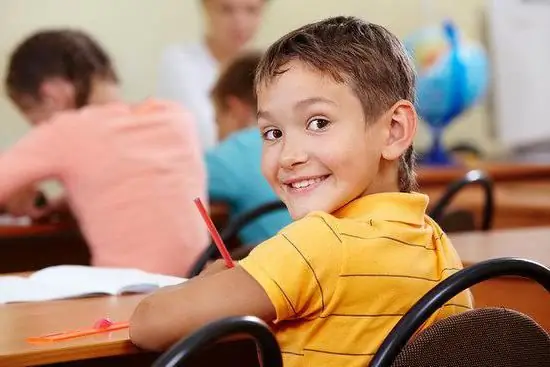2025 Author: Priscilla Miln | [email protected]. Last modified: 2025-01-22 17:55:15
Preschoolers explore the world through play. They enjoy competing with each other, rescuing animals in trouble, solving puzzles and guessing riddles. At the same time, they receive the necessary knowledge about the world around them, learn to count, read, compare objects. Didactic games for children play an important role in preschool education. Willingly joining them, kids develop their abilities, overcome the first difficulties and actively prepare for entering school.
Definition
Didactic game combines two principles: educational and entertaining. It consists of the following components:
- Cognitive task, which for children is formulated as a game ("Collect a picture", "What tree did the leaf fly off from?", "Continue the ornament"). Having entered an imaginary situation, the child happily joins the work process.
- Content. Itmay be the most varied. Games form mathematical representations and sensory standards in children, develop speech, ear for music, and introduce natural patterns.
- Game actions that are designed to arouse joy and interest in the child. At the same time, they develop children's abilities, skills and abilities.
- Set rules. Their task is to direct the attention of the players to the fulfillment of a certain goal, as well as to regulate their relationship with each other.
- Summing up. This can be verbal praise of the teacher, scoring, identifying the winner.

Goals of didactic games
Children like to collect puzzles, play lotto and dominoes, go through mazes, color pictures. For them, it's fun. In fact, the goals of didactic games are much more serious. Participating in them, children:
- develop logical thinking, memory, attention, perseverance;
- receive and learn to put into practice elementary knowledge;
- enrich vocabulary, learn to communicate, express their thoughts;
- get used to following the rules, to regulate their behavior by force of will;
- form moral qualities: justice, sympathy, compliance, perseverance;
- learn to adequately respond to victories and defeats;
- develop fine motor skills of hands, get positive emotions.

Classification
In pedagogy, the following types of didactic games are distinguished:
- Desk-printed. These include paired and split pictures, lotto, puzzles, dominoes, thematic games ("Whose cub?", "The third extra", "When does this happen?"), mosaics, checkers, folding dice. Their feature is the reliance on the visual perception of information by children.
- Games with objects. They are widely used in classes with children of primary preschool age. Toddlers learn to manipulate toys, natural materials, real objects. At the same time, they get acquainted with the concepts of size (matryoshka), shape (sorter), color, etc.
- Didactic games for the development of speech. They involve solving problems on a mental plane, without relying on visualization. Children must use their knowledge in new circumstances: guess which animal is described; quickly group items ("Edible-inedible"); pick the right word ("Say the opposite").
Use in preschool education
Knowledge of the world around us is a natural aspiration of preschoolers. In their games, they recreate the real world, learn to act, imitating adults. At the same time, a lively interest arises, mental processes are activated. The didactic game, according to the Federal State Educational Standard, meets the age needs of the child. It is a necessary component in the educational process. In this case, an important role is assigned to the teacher.
The task of the educator is to get the kids interested in the game. For this, various fairy-tale characters are used ("Heroes got lost"), a surprise moment ("Who hid inside the matryoshka?"),imaginary situations ("The snowman cannot find a pair for his mitten"). During the game, a joyful tone is maintained, and the use of jokes is encouraged. Children should not feel that they are being purposefully taught something, otherwise a protest is born. They also care about the effect of novelty, the constant complication of the tasks.
Games with objects and toys
Kids enthusiastically collect pyramids, build towers from cubes and constructor, lay out figures from counting sticks and shoelaces, count cones, look for beans in the sand. At the same time, they learn to compare objects according to different criteria, independently determine the correct sequence of actions. Such didactic games for preschoolers are especially important in the younger and middle groups.

Children 2-3 years old operate with objects that differ sharply from each other. In the middle group, the tasks become more difficult. At this age stage, the difference between the game material becomes less obvious. Memory is actively trained: the children should look at the toy for a few seconds and find the same one, notice which object has disappeared or changed its location. Children learn to string beads, cope with laces, assemble whole parts from parts, lay out patterns.
Story-didactic games are widely used. So, portraying buyers and sellers, children consolidate knowledge about fruits and vegetables, learn to count, distinguish colors ("Give me one green apple").
Printable board games
Children of all ages enjoy playing with them. OftenThe rules require the participation of several children. The following types of didactic games for preschoolers can be distinguished:

- Selection of paired pictures. For kids, these will be the same images. Older preschoolers are given a more difficult task. For example, find pictures with the same number of items, regardless of their color, size, shape, etc. This also includes popular games of lotto, dominoes.
- Finding images united by a common feature ("What grew in the garden, and what - in the garden?"). Such games can be devoted to a wide variety of topics.
- "What has changed?". Children remember the content, number, and location of pictures. They need to notice the teacher's changes.
- Folding cut pictures, puzzles.
- Showing a drawn object or action using gestures, facial expressions, sound imitation. At the same time, the rest of the participants in the game must guess what it is about.
- Passing the labyrinth by several participants with moving chips around the field, throwing a dice, observing the proposed rules.
Didactic games for speech development
They teach preschoolers to listen carefully to others, apply knowledge, focusing on the task, quickly select the answer, clearly formulate their thoughts. Conducting such didactic games in the older group helps prepare children for the upcoming schooling.

Provisionally all verbal funcan be divided into 4 groups:
- Games that teach children to highlight the essential features of phenomena, objects. This includes all sorts of riddles when, according to the description, you need to recognize an animal, a person, a toy, etc.
- Games that form in children the ability to compare objects, find alogisms, build correct conclusions ("Fables", "What do day and night have in common?").
- Games that form the skills of generalization and classification ("How to say in one word?", "I know 5 names").
- Entertainment that develops attention, endurance, reaction speed and a sense of humor ("Do not walk in black and white", "Flies, does not fly").
Computer games
Information technology is now used everywhere. It is not surprising that the use of didactic games of a new type is actively promoted in kindergartens. Computer games are very interesting for modern kids, they present educational material in a bright, unusual way. All this helps to quickly remember it.

The child needs to press the keys, click the mouse on the screen, while watching the changing pictures. This is how the skill of anticipating one's actions, the speed of reaction develops. The child has to solve entertaining problems on his own, while it becomes possible to individualize learning. Kids feel free, not afraid to make mistakes, master the basics of computer literacy.
However, screen games should not be allowed tolengthy. Preschoolers 5 years old can spend up to 20 minutes a day at the computer, six-year-olds - no more than half an hour.
Organization Methodology
Playing a game in a group involves:
- Introducing the children to the objects used, pictures, organizing a short conversation on their content.
- Explanation of rules.
- Demonstration of game actions.
- Determining the role of the teacher. He can become an equal participant in the game, a fan or a referee.
- Summing up, mood for the joyful expectation of the next game.

Leading children's games, the teacher takes into account the age characteristics of the children. Younger preschoolers do not understand verbal explanation well, so it is accompanied by a demonstration. The surprise moment is of great importance. The teacher actively participates in the game, sets an example, creates a joyful atmosphere.
In the middle group, the teacher teaches children to play together, monitors compliance with the rules, gives advice in case of difficulty. Didactic games in the older group involve independent actions of children, which are preceded by a verbal explanation of the rules. The teacher encourages the manifestation of goodwill, mutual assistance, intervenes in case of a conflict situation.
Didactic game for children is a practical activity during which they learn to apply their knowledge and navigate in changing conditions. At the same time, curiosity, mental processes and the ability to control one's behavior develop, which will definitely come in handy whenadmission to first grade.
Recommended:
Silk fabric: types, description, properties and applications. Natural and artificial silk

Silk fabric is woven from natural, synthetic and artificial threads. The last two variations can be safely attributed to one group - chemical. Artificial silk is made from cellulose with chemical impurities, it has different characteristics and more affordable cost
Identification and development of gifted children. Problems of gifted children. School for gifted children. Gifted children are

Who exactly should be considered gifted and what criteria should be followed, considering this or that child the most capable? How not to miss the talent? How to reveal the hidden potential of a child who is ahead of his peers in terms of his level of development, and how to organize work with such children?
Children's musical games in kindergarten and their types

What kind of children's musical games can be held in kindergarten? This article describes the features of organizing and conducting various types of such activities, as well as examples of musical games for various age groups of preschool educational institutions
Sensorics - what is it? Didactic sensory games

Surely many have heard at least something about such a thing as "sensorics". What it is, however, not everyone can explain. Even fewer are those who are fully aware of the huge role that it plays in the life of every person, and especially a child. Moms and dads, who take a very responsible approach to the problem of education, should know that it is sensory development that is one of the main components of the harmonious and full development of the baby's personality
How to improve children's memory? Games for the development of memory. Vitamins to improve memory for children

Memory is a very good helper for every person. He does not need to write down important information in a notebook, and then try to find it for a long time. All of it is stored right in his head. This function is formed from birth. It is recommended to think as early as possible about how to improve the memory of children

